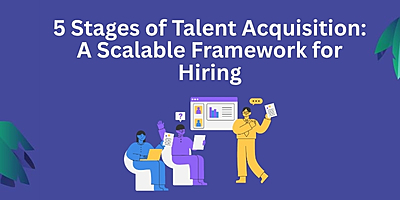The 5 Stages of Talent Acquisition: A Scalable Framework for Hiring

Why Talent Acquisition Needs a Scalable Framework
Hiring the right talent at the right time can significantly impact your growth trajectory. Yet, many businesses still treat recruitment as a reactive task, filling roles only as they become available rather than creating a system that scales with demand.
This is where a structured approach matters. The 5 stages of talent acquisition — planning, sourcing, screening, selection and onboarding — can, when carefully executed, create a repeatable framework that supports fast, confident hiring.
Here’s how each stage works, and why it’s essential for high-growth businesses:
Planning: Is hiring always last-minute?
If your team often faces last-minute deadlines and scrambles to fill roles, it’s a clear sign that proper planning is absent. Reactive hiring often leads to rushed decisions, poor role clarity and higher turnover.
A structured planning stage focuses on workforce planning: anticipating future talent needs, mapping current workforce skills and aligning job roles with business strategy. This ensures sustainable growth and turns hiring from a reactive task into a strategic advantage.
Sourcing: Not seeing the right candidates?
Posting jobs and waiting rarely delivers top talent, especially for niche positions. If CVs coming through are missing the mark, it’s time to rethink your sourcing strategy.
By using targeted candidate sourcing techniques and activating passive talent pools, you can attract candidates who are skilled, available and culturally aligned. Strong sourcing forms the backbone of any successful talent acquisition process, ensuring the right talent pipeline is always ready. A scalable hiring model keeps sourcing aligned with growth, enabling you to secure the right talent faster and more consistently.
Screening: Is your shortlisting slowing you down?
When screening isn’t structured, good candidates are often lost and hiring slows down. Even bias can creep into the process without consistent criteria.
A clear candidate screening process solves this. Using scorecards, assessments and automation speeds up shortlisting while ensuring fairness and consistency. The result? A stronger shortlist and a smoother talent acquisition strategy overall.
Selection: Losing great candidates before the offer stage?
Lengthy interview rounds and slow decisions frustrate candidates and hiring managers alike. In today’s competitive market, great talent doesn’t wait.
A structured interview and selection process defines clear steps, assigns ownership and speeds up decision-making. By streamlining feedback and empowering decision-makers, businesses reduce dropouts and accelerate every stage of the hiring process steps.
Onboarding: Are new hires leaving too soon?
What is onboarding if not the first and lasting impression that sets the tone for the entire employee experience? Without structure, new hires can feel disconnected, unclear about expectations and disengaged — often leading to early exits.
A defined employee onboarding process ensures clarity and support from day one, improving retention and productivity while protecting your investment in talent.
Why these 5 stages of Talent Acquisition matter ?
Building a repeatable talent acquisition process reduces instability in unpredictable hiring markets. Together, these five steps create a strategic hiring framework that supports scale, speed and quality of hiring — everything a growing business needs to stay competitive.
How Troi helps
At Troi, we don’t just advise on hiring — we integrate with your team through embedded hiring solutions, running your talent recruitment function as if it were our own. This approach gives you the speed and flexibility of an in-house team, without the overheads, and evolves with your long-term goals.
If your staffing requirements are growing or your process feels stuck, it may be time to rethink your approach to recruitment. With Troi, you can build a hiring engine that expands alongside your goals.